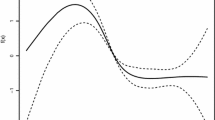Summary
We give a credibility approach to the Munich chain-ladder (MCL) method introduced by Quarg & Mack [8]. If we use a credibility approach (best affine-linear predictors) to estimate claims reserves, the model assumptions underlying the MCL method can be reduced to the usual model assumptions of the classical chain-ladder model of Mack [5]. This shows that the MCL model defined by Quarg & Mack [8] is a natural extension of the classical Mack model [5] in a linear Bayesian framework, and that MCL estimators are locally optimal linear predictors in this context.
Zusammenfassung
Wir betrachten einen auf der Credibility-Theorie basierenden Ansatz, der zur Munich Chain-Ladder Methode (MCL-Methode) von Quarg & Mack [8] führt. Die Verwendung von optimalen affin-linearen Prädiktoren zur Prognose der Schadenreserve ermöglicht die Einschränkung der Annahmen des MCL-Modells [8] auf die wohlbekannten Annahmen des Modells von Mack [5]. Dieser Zugang zeigt, dass das MCL-Modell von Quarg & Mack [8] innerhalb der linear Bayes-Theorie als eine natürliche Erweiterung des Modells von Mack [5] aufgefasst werden kann und die Schätzer der MCL-Methode lokal optimale lineare Prädiktoren sind.
Similar content being viewed by others
Literatur
Benktander, G. (1976). An approach to credibility in calculating IBNR for casualty excess reinsurance.The Actuarial Review, April 1976, 7.
Brockwell, P. J. and Davis, R. A. (1991).Time Series: Theory and Methods. Springer-Verlag, Berlin.
Bühlmann, H. and Gisler, A. (2005).A Course in Credibility Theory and its Applications. Springer-Verlag, Berlin.
Halliwell, L. J. (1997). Conjoint prediction of paid and incurred losses.CAS Forum Summer 1997, vol. 1, 241–379.
Mack, T. (1993). Distribution-free calculation of the standard error of Chain Ladder reserve estimates.Astin Bulletin 23, 2, 213–225.
Mack, T. (2000). Credible claims reserves: The Benktander method.ASTIN Bulletin 30, 2, 333–347.
Neuhaus, W. (1992). Another pragmatic loss reserving method or Bornhuetter/Ferguson revisited.Scandinavian Actuarial Journal 1992, 151–162.
Quarg, G., Mack, T. (2004). Munich Chain Ladder.Blätter der DGVFM, Band XXVI, 597–630.
Vylder De, F. (1982). Estimation of IBNR claims by credibility theory.Insurance: Mathematics and Economics 1, 35–40.
Witting, T. (1987). Kredibilitätsschätzungen für die Anzahl IBNR-Schäden.Blätter der DGVFM, Band XVIII, 45–58.
Author information
Authors and Affiliations
Corresponding author
Rights and permissions
About this article
Cite this article
Merz, M., Wüthrich, M.V. A credibility approach to the munich chain-ladder method. Blätter DGVFM 27, 619–628 (2006). https://doi.org/10.1007/BF02809220
Issue Date:
DOI: https://doi.org/10.1007/BF02809220




